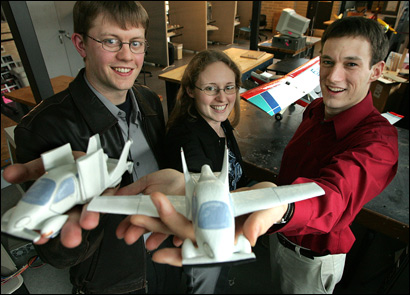Flying Cars, Swimming Planes--I Want One that Does Them All
 JW Bats of Our Technological Future Blog reports on the "Flying Car Project" at MIT. Here is the link to the newspaper article describing the project. Carl Dietrich is a 28 year old aerospace engineer with a record of innovation.
JW Bats of Our Technological Future Blog reports on the "Flying Car Project" at MIT. Here is the link to the newspaper article describing the project. Carl Dietrich is a 28 year old aerospace engineer with a record of innovation.''People tend to smirk when you say you're trying to make a flying car: 'Oh, you're one of those guys.' " But, he insisted, ''This isn't just another flying car concept. We're very serious about producing a flying car and selling it."
Few who know Dietrich would bet against him. Even by MIT's standards, he is considered a standout -- so much so, in fact, that today he will be announced as the winner of the $30,000 Lemelson-MIT Student Prize. An outside panel of scientists and technologists chose Dietrich for his ''portfolio of novel inventions," including not just the flying car but also a desktop-size fusion reactor and a lower-cost rocket engine.

I wish Dietrich and his team the best of luck, since they plan to begin manufacturing the flying car in 2009. This other fellow has been trying to get his flying car ready for production and marketing for a long time.
CNN.com has an interesting story about a swimming plane that will be launched from a submarine 150 feet below the ocean's surface. The plane will swim to the surface and take off for its flight. At the end of its flight, the plane will land on the ocean and wait to be picked up by a robotic underwater vehicle..
The Cormorant, a stealthy, jet-powered, autonomous aircraft that could be outfitted with either short-range weapons or surveillance equipment, is designed to launch out of the Trident missile tubes in some of the U.S. Navy's gigantic Cold War--era Ohio-class submarines.
....The tubes are as long as a semi trailer but about seven feet wide -- not exactly airplane-shaped. The Cormorant has to be strong enough to withstand the pressure 150 feet underwater -- enough to cave in hatches on a normal aircraft -- but light enough to fly.
....The craft is made of titanium to resist corrosion, and any empty spaces are filled with plastic foam to resist crushing. The rest of the body is pressurized with inert gas. Inflatable seals keep the weapon-bay doors, engine inlet and exhaust covers watertight.

The Cormorant does not shoot out of its tube like a missile. Instead an arm-like docking "saddle" guides the craft out, sending it floating to the surface while the sub slips away. As the drone pops out of the water, the rocket boosters fire and the Cormorant takes off.
After completing its mission, the plane flies to the rendezvous coordinates it receives from the sub and lands in the sea. The sub then launches a robotic underwater vehicle to fetch the floating drone.
Here is the thing: I would like a car that can function as a camper, can swim on the water's surface, can dive like a submarine, and can fly like a plane. Engineers are beginning to think out of the box--just a little. But not nearly enough.
It is not a good sign that engineering enrollment in North America has declined. Although India and China can certainly produce top notch engineers, the jury is still out as to whether engineers trained in Asia are as innovative as European and North American trained engineers. We will all hope so, given the trends.
By the way, I have posted on the issue of declining engineering enrollments here, here, here, and here. It is one thing to wish nature had done things differently, it is quite another to base the future of your society on that wishful thinking, when you know it is not true.
Labels: adventure toys 4, Terrafugia

0 Comments:
Post a Comment
“During times of universal deceit, telling the truth becomes a revolutionary act” _George Orwell
<< Home